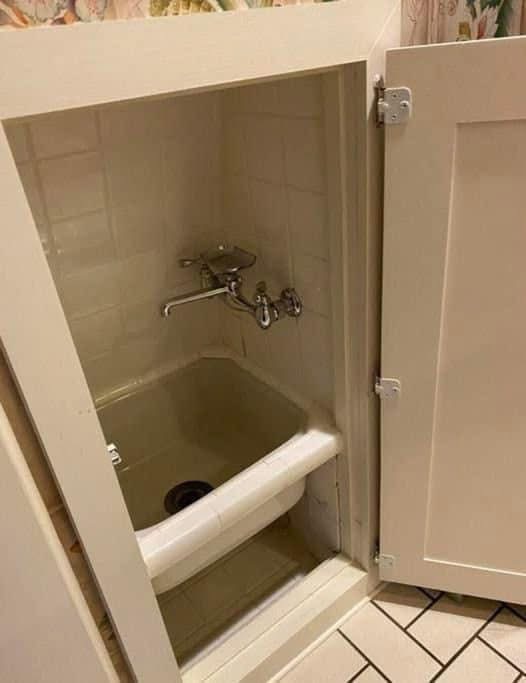
When you first glance at the image, it looks like a tiny tub or sink tucked away behind a door in the wall. At first sight, you might wonder: Is it for washing babies? Pets? Laundry? Or is it just a weird architectural quirk from a bygone era?
The truth is, fixtures like these were once fairly common in older homes, especially those built in the early to mid-20th century. They were designed for practical household purposes, not for human bathing, and they reflect the clever but unusual designs of the time.
What Is It?
This compact built-in fixture is often referred to as a laundry sink, mop sink, or utility tub. Unlike modern laundry rooms that often feature tall, deep tubs on stands, this one was recessed directly into the wall and hidden behind cabinetry doors to keep the room looking tidy.
It’s smaller than a bathtub but deeper than a regular sink, designed for tasks like:
- Hand-washing delicate clothes or linens
- Soaking heavily soiled laundry before washing
- Filling mop buckets or rinsing out cleaning rags
- Washing small pets (cats, dogs, rabbits)
- Even bathing infants in some households
The hidden design shows how homeowners of the time wanted to combine practicality with aesthetics, keeping the less glamorous parts of housekeeping out of sight.
A Peek into Its History
Fixtures like these were most popular from the 1920s through the 1950s, especially in middle-class suburban homes. Before the rise of modern washing machines and utility sinks, families needed a designated place to deal with dirty chores.
- 1920s–30s: Many homes had built-in laundry sinks in the kitchen or basement.
- 1940s–50s: As postwar homes grew in size, laundry and utility rooms became separate spaces, and these small recessed tubs often found a home there.
- 1960s onward: The design faded out, replaced by larger, freestanding laundry tubs or plastic utility sinks that were cheaper to install.
Today, finding one of these behind a cupboard door feels like opening a time capsule.
Why the Hidden Door?
Practicality met style here. Households wanted to keep utility fixtures accessible yet concealed. By placing a door over the tub:
- The room looked neater and more formal.
- Odors from wet laundry or dirty mop water could be contained better.
- It matched cabinetry, blending into the décor.
Think of it as an early attempt at the “minimalist” look—decades before modern design trends.
Benefits of These Old Fixtures
Even though modern homeowners might chuckle at its appearance, these hidden sinks had their perks:
- Durability – Made from heavy porcelain or enameled cast iron, they lasted generations.
- Multi-purpose – From laundry to pets, they were incredibly versatile.
- Space-saving – Built into walls or cabinetry, they didn’t clutter up a room.
- Sanitation – Allowed for cleaning messy tasks outside the kitchen sink.
Modern-Day Uses
If you discover one of these quirky fixtures in an old home, don’t rip it out just yet. With some imagination, it can still serve useful purposes today:
- Pet bath for small animals
- Plant-watering station
- Vintage-style laundry soak basin
- Mudroom wash station for boots and dirty hands
Some homeowners even restore them for charm, turning them into conversation pieces when guests spot the hidden door.
Conclusion
This small hidden tub-sink isn’t just a quirky piece of plumbing—it’s a reminder of how homes once functioned. Long before the age of high-efficiency washers, Roombas, and minimalist laundry rooms, households relied on smart built-ins like this to handle daily chores.
What might look strange to us today was once an essential part of family life. It’s a blend of history, practicality, and charm, showing how design evolves with changing lifestyles.
So the next time you stumble upon one of these tucked-away relics, know that you’ve uncovered a small but fascinating chapter of domestic history.